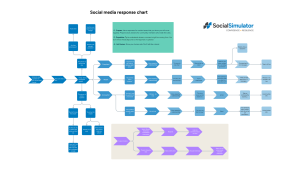Social media is often the first place people go to interact with a brand, whether to ask a question, give praise, or lodge a complaint. Knowing how to respond appropriately and consistently is essential for building trust and maintaining a positive online reputation.
This article distills a helpful social media response flowchart into actionable steps, offering a simple framework for handling interactions across platforms.
🧭 Step 1: Understand the nature of the message
Start by asking yourself: What is this person saying?
Are they:
- Being kind or complimentary?
- Asking a question?
- Making a complaint?
- Sharing an accusation or concern?
- Posting abusive or inappropriate content?
Your next step depends entirely on the tone and purpose of their message.
😊 Positive interactions: kindness, comments, praise
When a user is friendly or positive, use it as an opportunity to engage and strengthen the relationship.
✔️ If they’re giving praise:
- Thank them sincerely.
- Consider resharing their post or amplifying their voice.
✔️ If it’s a neutral comment:
- Acknowledge the message.
- Use it to spark a friendly interaction or add value to the conversation.
❓ Questions: Know when to answer or escalate
✔️ If you know the answer:
- Respond clearly and publicly.
- If the answer is too long, link to a relevant webpage for more information.
🚧 If you don’t know the answer:
- Use a holding message (“Thanks for your question, we’re looking into it”).
- Escalate internally and aim to follow up quickly.
- If needed, take the conversation offline for a deeper discussion.
😡 Complaints, accusations, and attacks
Negative comments need careful handling to show that your brand listens and cares, even when under fire.
🧠 General rule:
- Always show empathy and try to understand the user’s frustration.
- Where possible, publicly demonstrate that you're taking action.
⚠️ Examples:
- Complaint: “I stayed in all day and my delivery didn’t arrive.”
“I’m sorry to hear that. What’s your order number so I can look into it?”
- Accusation: “You’re the worst company!”
“I’m sorry you feel that way. Has something specific caused your frustration?”
- Critical feedback: “Your product contains palm oil.”
If true, acknowledge it and show your intent to address the issue.
If false, calmly rebut with accurate information and a link.
🔄 After 2–3 responses:
- If the issue is still unresolved or emotions are high, move the conversation offline or offer to follow up via private channels.
🚨 When to escalate or report
For more serious concerns:
- Spam, swearing, confidential data, or abuse:
➤ Hide or delete the comment.
➤ Take screenshots.
➤ Block the user if necessary.
➤ Escalate internally and, if appropriate, report the user to the platform or authorities.
- Security threats or sensitive issues:
➤ Flag the situation immediately to the relevant internal team.
➤ Do not engage publicly.
🧰 Use the P.E.A. framework
A simple but powerful reminder for every interaction:
- P – Prepare
Have stock responses ready for FAQs or known sensitive issues. Draft messages for dealing with rule-breaking users.
- E – Empathise
Assume good intent and try to understand the context behind a user’s frustration or question.
- A – Act Human
Avoid sounding robotic. Use a conversational tone and show there’s a real person behind the screen.
🎯 Final thoughts
Not every social media interaction needs a perfectly crafted response, but every response should be thoughtful. By listening, showing empathy, and acting human, you can turn even a complaint into an opportunity to demonstrate your brand's values.
Download a copy of our Social Media Response Chart
